
BM-004
Trang 1 / 5
TRƯỜNG ĐẠI HỌC VĂN LANG
ĐƠN VỊ: KHOA NGOẠI NGỮ
ĐỀ THI, ĐÁP ÁN/RUBRIC VÀ THANG ĐIỂM
THI KẾT THÚC HỌC PHẦN
Học kỳ 3, năm học 2023-2024
I. Thông tin chung
Tên học phần:
Advanced Translation
Mã học phần:
71ENGL40763
Số tín chỉ:
3
Mã nhóm lớp học phần:
233_71ENGL40763_0102
Hình thức thi: Tự luận
Thời gian làm bài:
100
phút
Thí sinh được tham khảo tài liệu:
☐ Có
☒ Không
II. Các yêu cầu của đề thi nhằm đáp ứng CLO
Ký
hiệu
CLO
Nội dung CLO
Hình
thức
đánh giá
Trọng số
CLO trong
thành phần
đánh giá (%)
Câu hỏi
thi số
Điểm
số
tối đa
Lấy dữ
liệu đo
lường
mức đạt
PLO/PI
(1)
(2)
(3)
(4)
(5)
(6)
(7)
CLO 1
Ứng dụng kỹ
thuật biên dịch
vào công việc
thực tiễn
tự luận
60%
từ Câu
hỏi 1 đến
Câu hỏi
5
10
CLO 2
Áp dụng các kỹ
năng trình bày
băng văn bản
tự luận
40%
từ Câu
hỏi 1 đến
Câu hỏi
5
10
III. Nội dung câu hỏi thi
Câu hỏi 1 (2 điểm): Translate the following passage into Vietnamese.
If we want to know where our capability for complex language came from, we need to look
at how our brains are different from other animals. This relates to more than just brain size;
it is important what other things our brains can do and when and why they evolved that way.
And for this there are very few physical clues; artefacts left by our ancestors don't tell us
what speech they were capable of making. One thing we can see in the remains of early
humans, however, is the development of the mouth, throat and tongue. By about 100,000
years ago, humans had evolved the ability to create complex sounds. Before that,

BM-004
Trang 2 / 5
evolutionary biologists can only guess whether or not early humans communicated using
more basic sounds.
Notes: artefact = an object that is made by a person, especially something of historical or
cultural interest
to evolve = to develop gradually, especially from a simple to a more complicated
form
Câu hỏi 2 (2 điểm): Translate the following passage into Vietnamese.
What Is Corporate Social Responsibility?
Businesses that practice corporate social responsibility aim to improve their communities,
the economy or the environment.
Corporate social responsibility is a type of business self-regulation with the aim of social
accountability and making a positive impact on society. Some ways that a company can
embrace CSR include being environmentally friendly and eco-conscious; promoting
equality, diversity, and inclusion in the workplace; treating employees with respect; giving
back to the community; and ensuring business decisions are ethical.
Notes: accountability = the fact of being responsible for your decisions or actions and
expected to explain them when you are asked
Câu hỏi 3 (2 điểm): Translate the following passage into English.
Theo cảnh báo của Liên hiệp quốc, giá thực phẩm có thể tăng 30-40% tại khu vực Tây Phi.
Thêm vào đó là sự bất ổn về an ninh, chính trị tại Mali cũng làm cho vấn đề cung ứng hàng
hóa nói chung trở nên phức tạp.
Mali có nền kinh tế mở trong đó ngoại thương chiếm 58% GDP. Mục tiêu chính của chính
sách thương mại nước này là tiếp tục thực hiện chương trình điều chỉnh cơ cấu theo khuyến
nghị của Quỹ tiền tệ quốc tế (IMF) nhằm đa dạng hóa nền kinh tế và ngoại thương. Thuế
nhập khẩu của Mali tương đối thấp (trung bình khoảng 10%) và có rất ít trở ngại về pháp lý
hay pháp quy đối với hoạt động thương mại.
Câu hỏi 4 (2 điểm): Translate the following passage into English.
Kostas Mastoras, chủ sở hữu chuỗi cửa hàng bán lẻ Titan Foods ở thành phố New York, cho
biết: “Năm 2021 là một năm khó khăn đối với các doanh nghiệp nhỏ, nhưng hầu hết trong số
đó vẫn tồn tại nhờ sự hỗ trợ của chính phủ. Năm 2022 sẽ còn khó khăn hơn vì nhiều thách
thức mà các doanh nghiệp nhỏ phải đối mặt vào năm 2021 vẫn còn như thiệt hại liên quan
đến COVID-19, tắc nghẽn chuỗi cung ứng, thiếu lao động và chi phí nguyên liệu và năng
lượng tăng. Trong khi đó, các chương trình cứu trợ của chính phủ tung ra hồi năm ngoái đang
bị rút dần."
Câu hỏi 5 (2 điểm): Translate the following passage into English.
Thử thách trước mắt
Tuy là nước ít chịu ảnh hưởng của cơn khủng hoảng tài chính-tiền tệ so với nhiều nước khác
những năm qua chúng ta cũng đã tiêu hao không ít nội lực để chống đỡ với bão táp phong
ba. Các nhà phân tích thời cuộc đánh giá cao về thành quả ấy nhưng rõ ràng nền kinh tế của
chúng ta vẫn phải trả giá: chỉ số tăng trưởng giảm ở mức thấp nhất từ nhiều năm qua; đầu tư

BM-004
Trang 3 / 5
nước ngoài giảm sút nghiêm trọng; xuất khẩu -ngoại trừ gạo- gặp khó khăn. May mắn là
tình hình nông nghiệp khả quan đã giúp ổn định được tình hình kinh tế xã hội.
ĐÁP ÁP VÀ THANG ĐIỂM
Phần câu hỏi
Nội dung đáp án
Thang điểm
Ghi chú
I. Tự luận
Câu 1
2.0
Nội dung
Nếu muốn biết khả năng sử dụng ngôn
ngữ phức tạp của chúng ta đến từ đâu,
chúng ta cần xem bộ não của chúng ta
khác với não của các loài động vật khác
như thế nào. Điều này không chỉ liên
quan đến kích thước não; điều quan
trọng là bộ não của chúng ta có thể làm
những việc gì khác, khi nào và tại sao
chúng lại phát triển theo cách đó. Và về
điều này có rất ít manh mối vật lý;
những vật dụng cổ do tổ tiên chúng ta để
lại không cho chúng ta biết họ có khả
năng nói những gì. Tuy nhiên, một điều
chúng ta có thể thấy ở hài cốt của con
người thời kỳ đầu là sự phát triển của
miệng, cổ họng và lưỡi. Khoảng 100.000
năm trước, con người đã phát triển khả
năng tạo ra những âm thanh phức tạp.
Các nhà sinh học tiến hóa chỉ có thể
đoán xem liệu trước đó con người
nguyên thủy có giao tiếp bằng những âm
thanh cơ bản hơn hay không.
Câu 2
2.0
Trách nhiệm xã hội của doanh nghiệp là
gì?
Các doanh nghiệp thực hiện trách nhiệm
xã hội của doanh nghiệp nhằm mục đích
cải thiện cộng đồng, nền kinh tế hoặc
môi trường của họ.
Trách nhiệm xã hội của doanh nghiệp là
một loại hình doanh nghiệp tự điều
chỉnh nhằm mục đích thực hiện trách
nhiệm xã hội và tạo ra tác động tích cực
đến xã hội. Một số cách mà một công ty
có thể áp dụng CSR bao gồm thân thiện
với môi trường và có ý thức về sinh thái;
thúc đẩy sự bình đẳng, đa dạng và hòa

BM-004
Trang 4 / 5
nhập tại nơi làm việc; đối xử tôn trọng
với nhân viên; cống hiến cho cộng đồng;
và đảm bảo các quyết định kinh doanh là
có đạo đức.
Câu 3
2.0
Nội dung
According to a United Nations warning,
food prices could increase by 30-40% in
West Africa. In addition, security and
political instability in Mali also makes
the problem of supplying goods
complicated in general.
Mali has an open economy in which
foreign trade accounts for 58% of GDP.
The main goal of this country's trade
policy is to continue implementing the
structural adjustment program as
recommended by the International
Monetary Fund (IMF) to diversify the
economy and foreign trade. Mali's
import taxes are relatively low (average
around 10%) and there are few legal or
regulatory impediments to trade.
Câu 4
2.0
Nội dung
“The year 2021 was a difficult year for
small businesses, but most of them
survived thanks to government support,”
said Kostas Mastoras, owner of Titan
Foods in Queens, New York. "2022 will
be even more difficult, as many of the
challenges they faced in 2021 remain,
like COVID-19 related costs, supply
chain bottlenecks, labor shortages, and
rising material and energy cost remains.
Meanwhile, the government programs
that saved them last year fade away.”
Câu 5
2.0
Nội dung
Immediate Challenges
Being a country which has not been
much impacted by the monetary and
financial crisis that has plagued so many
countries all over the word, we have, in
the past year, consumed considerable
internal resources to fight against, and
survived from, such a stormy crisis.
Situation analysts have appreciated such
a performance; however, it is obvious
that our economy has paid a price: our

BM-004
Trang 5 / 5
economic growth rate has declined to the
lowest level in several years; foreign
direct investment has substantially
decreased; and exports -except rice - are
encountering numerous difficulties. It is
lucky that our agricultural sector has
displayed its normal development, thus
helping stabilize our socioeconomic
situation.
Điểm tổng
10.0
TP. Hồ Chí Minh, ngày 6 tháng 6 năm 2024
Trưởng bộ môn Giảng viên ra đề
Nguyễn Hải Long Đỗ Phú Anh


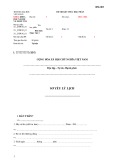
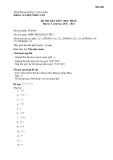
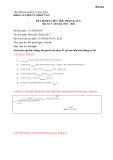
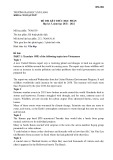


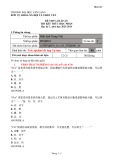
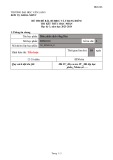
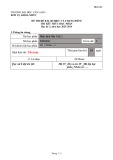

![Tài liệu Từ vựng tiếng Anh Trung cấp [mới nhất]](https://cdn.tailieu.vn/images/document/thumbnail/2025/20250913/nguyentuan250421@gmail.com/135x160/99491757910839.jpg)
![Tài liệu Từ vựng Tiếng Anh theo chủ đề [mới nhất]](https://cdn.tailieu.vn/images/document/thumbnail/2025/20250913/namdhuet@gmail.com/135x160/83251757753810.jpg)


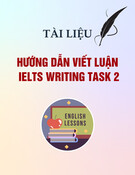
![Tài liệu Từ vựng tiếng Anh cho bé [chuẩn nhất/mới nhất]](https://cdn.tailieu.vn/images/document/thumbnail/2025/20250731/huadaithesang2509@gmail.com/135x160/18631754013896.jpg)








